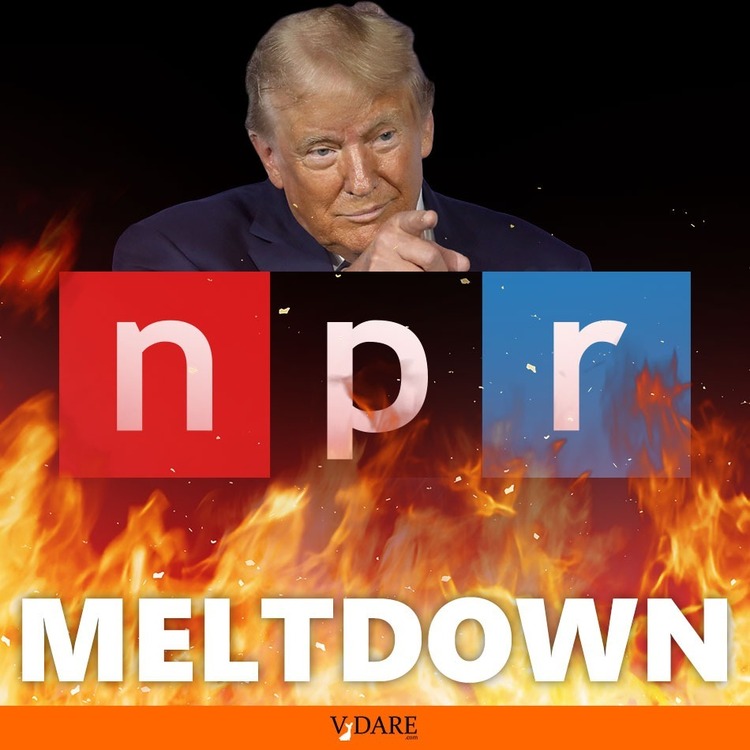


By Steve Sailer
04/09/2024
From Free Press:
I’ve Been at NPR for 25 Years. Here’s How We Lost America’s Trust.
Uri Berliner, a veteran at the public radio institution, says the network lost its way when it started telling listeners how to think.
By Uri Berliner
April 9, 2024
Berliner is in the business news section.
… Back in 2011, although NPR’s audience tilted a bit to the left, it still bore a resemblance to America at large. Twenty-six percent of listeners described themselves as conservative, 23 percent as middle of the road, and 37 percent as liberal.
2011 shows up on a lot of David Rozado’s graphs as the least woke year in the recent media, even better than 2010 and 2009. I suspect that the Democrats had a couple of positive accomplishments for the media to crow over in promoting Obama’s 2012 reelection — Obamacare and killing Osama — so the level of anti-core American hate was muted. Things started to slip in 2012 with the Trayvon Martin–George Zimmerman fiasco because white journalists tended to believe Black Twitter implicitly.
By 2023, the picture was completely different: only 11 percent described themselves as very or somewhat conservative, 21 percent as middle of the road, and 67 percent of listeners said they were very or somewhat liberal. …
From 2017-2019, NPR had RussiaGate to obsess over. But then that embarrassingly evaporated in 2019. At that point in August 2019 the NYT switched to its Plan B to dump Trump — Racism round the clock. Berliner doesn’t say that NPR did that, just that it went nuts over George Floyd in May 2020. CEO John Lansing (a Joe Biden–lookalike) announced:
In confessional language he said the leaders of public media, “starting with me — must be aware of how we ourselves have benefited from white privilege in our careers. We must understand the unconscious bias we bring to our work and interactions. And we must commit ourselves — body and soul — to profound changes in ourselves and our institutions.”
He declared that diversity — on our staff and in our audience — was the overriding mission, the “North Star” of the organization. Phrases like “that’s part of the North Star” became part of meetings and more casual conversation.
According to an NPR press release last year, “The main goal of his tenure was uniting NPR and Member stations under the ’North Star’ of diversifying the newsroom, content, and audiences. Under Lansing’s leadership, NPR’s executive team has evolved to include more than 40% people of color, from 9% in 2019.”
In other words, I’m okay, Jack. I’m CEO. But you younger white guys are hosed.
Most visible was a burgeoning number of employee resource (or affinity) groups based on identity. …
They included MGIPOC (Marginalized Genders and Intersex People of Color mentorship program); Mi Gente (Latinx employees at NPR); NPR Noir (black employees at NPR); Southwest Asians and North Africans at NPR; Ummah (for Muslim-identifying employees); Women, Gender-Expansive, and Transgender People in Technology Throughout Public Media; Khevre (Jewish heritage and culture at NPR); and NPR Pride (LGBTQIA employees at NPR).
… They became a priority for NPR’s union, SAG-AFTRA — an item in collective bargaining. The current contract, in a section on DEI, requires NPR management to “keep up to date with current language and style guidance from journalism affinity groups” and to inform employees if language differs from the diktats of those groups. In such a case, the dispute could go before the DEI Accountability Committee.
In essence, this means the NPR union, of which I am a dues-paying member, has ensured that advocacy groups are given a seat at the table in determining the terms and vocabulary of our news coverage. …
And this, I believe, is the most damaging development at NPR: the absence of viewpoint diversity. …
I found 87 registered Democrats working in editorial positions and zero Republicans. None. …
Because for all the emphasis on our North Star [Diversity!], NPR’s news audience in recent years has become less diverse, not more so. Back in 2011, our audience leaned a bit to the left but roughly reflected America politically; now, the audience is cramped into a smaller, progressive silo.
Despite all the resources we’d devoted to building up our news audience among blacks and Hispanics, the numbers have barely budged. In 2023, according to our demographic research, 6 percent of our news audience was black, far short of the overall U.S. adult population, which is 14.4 percent black. And Hispanics were only 7 percent, compared to the overall Hispanic adult population, around 19 percent. Our news audience doesn’t come close to reflecting America. It’s overwhelmingly white and progressive, and clustered around coastal cities and college towns.